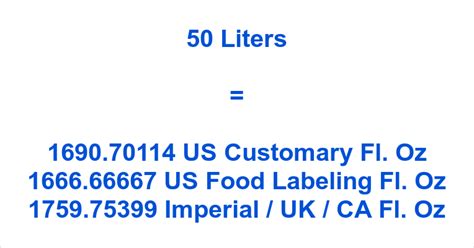How Many Ounces In 50 Litres
Kalali
Apr 04, 2025 · 4 min read

Table of Contents
How Many Ounces in 50 Liters? A Comprehensive Guide to Metric and Imperial Conversions
Converting between metric (liters) and imperial (ounces) units can be tricky, especially when dealing with larger quantities like 50 liters. This comprehensive guide will not only answer the question "How many ounces are in 50 liters?" but also provide you with the tools and understanding to make similar conversions yourself. We'll explore the conversion process, delve into the nuances of different ounce types, and offer practical applications of this knowledge.
Understanding the Units: Liters and Ounces
Before diving into the calculation, let's clarify the units involved:
-
Liter (L): The liter is a metric unit of volume. It's a fundamental unit in the International System of Units (SI). One liter is equivalent to 1 cubic decimeter (dm³).
-
Ounce (oz): The ounce is an imperial unit of volume and weight (avoirdupois and fluid ounces). This is where things get a little complicated. We need to differentiate between fluid ounces (a unit of volume) and avoirdupois ounces (a unit of weight/mass). For volume conversions involving liters, we're exclusively concerned with fluid ounces.
The Conversion: Liters to Fluid Ounces
The key conversion factor we need is:
1 liter ≈ 33.814 fluid ounces (fl oz)
This means that one liter is approximately equal to 33.814 fluid ounces. The "approximately" is important because these are different systems of measurement with slightly varying definitions.
Now, let's calculate how many fluid ounces are in 50 liters:
50 liters * 33.814 fl oz/liter ≈ 1690.7 fluid ounces
Therefore, there are approximately 1690.7 fluid ounces in 50 liters.
Precision and Rounding
The result (1690.7 fl oz) is an approximation. Depending on the context, you might need to round this to a whole number or a specific number of decimal places. For most practical purposes, rounding to one decimal place (1690.7 fl oz) is sufficient. However, if you need extreme precision for scientific or engineering applications, you should use the full value or a more precise conversion factor.
Practical Applications: Where You Might Need This Conversion
Understanding the conversion between liters and fluid ounces is crucial in various situations:
-
Cooking and Baking: Many recipes, especially those originating from countries using the imperial system, might list ingredient volumes in fluid ounces. If you're working with metric measurements, this conversion is essential.
-
Beverage Industry: The beverage industry often uses both metric and imperial units. Converting between liters and fluid ounces is vital for labeling, importing, and exporting.
-
Chemical and Pharmaceutical Industries: Precise measurements are critical in these fields. Accurate conversion between liters and fluid ounces ensures the correct quantities of substances are used.
-
Automotive and Mechanical Engineering: Fluid capacities in vehicles and machinery are often specified in liters or fluid ounces.
-
International Trade: When dealing with global commerce, understanding both metric and imperial units is paramount.
Beyond the Basic Calculation: Further Exploration of Units
Let's expand our understanding by exploring related units and conversions:
Converting to other Imperial Units:
Once you have the volume in fluid ounces, you can easily convert it to other imperial units like:
- Pints (pt): 1 pint = 16 fluid ounces
- Quarts (qt): 1 quart = 32 fluid ounces
- Gallons (gal): 1 gallon = 128 fluid ounces
You can use these conversion factors to easily switch between fluid ounces and other imperial volume units.
Understanding Avoirdupois Ounces (Weight/Mass):
It's crucial to remember the distinction between fluid ounces (volume) and avoirdupois ounces (weight/mass). You cannot directly convert between them without knowing the density of the substance involved. Density is mass per unit volume (e.g., grams per milliliter or pounds per gallon).
For instance, one fluid ounce of water weighs approximately one avoirdupois ounce, but this is not true for other substances. The density of the substance determines the relationship between volume and weight.
Troubleshooting and Common Mistakes
Here are some common pitfalls to avoid when converting liters to fluid ounces:
-
Using the wrong conversion factor: Ensure you are using the correct conversion factor (1 liter ≈ 33.814 fluid ounces). Using an inaccurate factor will lead to incorrect results.
-
Confusing fluid ounces and avoirdupois ounces: Remember that fluid ounces measure volume, while avoirdupois ounces measure weight/mass. They are not interchangeable.
-
Incorrect rounding: Round your answer appropriately to the required level of precision. Over- or under-rounding can lead to significant errors, especially in scientific or engineering applications.
-
Using online converters without understanding the process: While online converters are convenient, understanding the underlying conversion process is essential to avoid errors and to troubleshoot any issues.
Conclusion: Mastering Liter to Fluid Ounce Conversions
Converting 50 liters to fluid ounces, and more generally, understanding conversions between metric and imperial units, is a valuable skill with numerous practical applications. By grasping the fundamental conversion factor and understanding the distinction between fluid ounces and avoirdupois ounces, you can confidently navigate these unit conversions in various contexts. Remember to always double-check your work and round your answers appropriately for the desired level of precision. This knowledge empowers you to tackle similar conversions with confidence and accuracy.
Latest Posts
Latest Posts
-
How Many Cups Are In 125 Ml
Apr 04, 2025
-
What Percent Of 120 I S6
Apr 04, 2025
-
Explain Why The Composition Of An Element Is Fixed
Apr 04, 2025
-
58 Inches Is How Many Feet
Apr 04, 2025
-
How Many Cups Is 64 Ounces Of Water
Apr 04, 2025
Related Post
Thank you for visiting our website which covers about How Many Ounces In 50 Litres . We hope the information provided has been useful to you. Feel free to contact us if you have any questions or need further assistance. See you next time and don't miss to bookmark.
